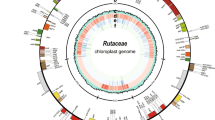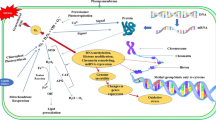Abstract
Ion-exchange chromatography of extracts from Trientalis europaea L. leaf tissue have been shown to contain two distinct isoforms of glutamine synthetase (GS). However, analysis by Western blotting has shown that the first peak to elute contains a mixture of large and small GS subunits, whilst the second peak is comprised entirely of a smaller subunit. This is contrary to the widespread assumptions concerning plant GS biochemistry. Isolation of intact chloroplasts and subsequent extraction of GS, followed by ion-exchange chromatography, has shown that the first peak to elute contains a large subunit, and the second chloroplastic peak is composed entirely of the small subunit. This smaller subunit may be present due to it being encoded by a separate chloroplastic GS gene, or it may be present as a product of post-translational modification. DNA sequencing has been used to try and determine which of these may be occurring. The three partial DNA sequences (505 nucleotides) we have obtained from T. europaea have been compared with 64 other sequences available on the NCBI database, which have mainly been obtained from crop species. Neighbour joining and parsimony analysis (1000 bootstrap) has shown support (∼30%) for the separation of plant GS from all other phyla. Within the plant phylum, there is total support for the separation of chloroplastic and cytosolic GS (100%), whilst the cytosolic sequences divide further into monocot and dicot species (77% support by NJ). Further subgroups of plants from the same families is also suggested. This is consistent with previous work containing fewer, but longer (∼1000 nucleotides) GS sequences. The addition of GS sequences obtained from wild plant species, such as T. europaea, to the large amount of information already available on the database, will permit a better understanding of the evolution of this important enzyme.
Similar content being viewed by others
References
Biesiadka J and Legocki AB 1997 Evolution of the glutamine synthetase gene in plants. Plant Sci. 128, 51–58.
Doyle JJ 1991 Evolution of higher plant glutamine synthetase genes: tissue specificity as a criterion for predicting orthology. Mol. Biol. Evol. 8, 366–377.
Elmlinger MW and Mohr H 1992 Glutamine synthetase in Scots pine seedlings and its control by blue light and light absorbed by phytochrome. Planta 188, 396–402.
Felsenstein J 1993 PHYLIP 3.3C. University of Washington, Seattle, USA.
Forde BG and Cullimore JV 1988 The molecular biology of glutamine synthetase in higher plants. Oxf. Surv. Plant Mol. Cell Biol. 6, 247–290.
García-Fernández JM, López-Ruiz A, Toribio F, Roldán JM and Diez J 1994 Occurrence of only one form of glutamine synthetase in the green alga Monoraphidium braunii. Plant Physiol. 104, 425–430.
Hirel B, Phillipson B, Murchie E, Suzuki A, Kunz C, Ferrario S, Limami A, Chaillou S, Deleens E, Brugière N, Chaumont-Bonnet M, Foyer C and Morot-Gaudry JF 1997 Manipulating the pathway of ammonia assimilation in transgenic non-legumes and legumes. Z. Pflanzenernähr. Bodenk. 160, 283–290.
McNally SF, Hirel B, Gadal P, Mann AF and Stewart GR 1983 Glutamine synthetases of higher plants – evidence for a specific isoform content related to their possible physiological role and their compartmentation within the leaf. Plant Physiol. 72, 22–25.
Minehart PL and Magasanik B 1992 Sequence of the GLN1 gene of Saccharomyces cerevisiae – Role of the upstream region in regulation of glutamine synthetase expression. J. Bacteriol. 174, 1828–1836.
Page RDM 1996 TreeView: an application to display phylogenetic trees on personal computers. Comp. Appl. Biosci. 12, 357–358.
Pearson J and Ji Y-M 1994 Seasonal variation of leaf glutamine synthetase isoforms in temperate deciduous trees strongly suggests different functions for the enzymes. Plant Cell Envir. 17, 1331–1337.
Rhodes D, Rendon GA and Stewart GR 1975 The control of glutamine synthetase in Lemna minor L. Planta 125, 201–211.
Schock G, Ochs G, Wild A 1994 Glutamine synthetase from roots of Brassica napus. Plant Physiol. 105, 757–758.
Woodall J and Forde BG 1996 Glutamine synthetase polypeptides in the roots of 55 legume species in relation to their climatic origin and the partitioning of nitrate assimilation. Plant Cell Envir. 19, 848–858.
Woodall J, Boxall JG, Forde BG and Pearson J 1996a Changing perspectives in plant nitrogen metabolism: the central role of glutamine synthetase. Sci. Prog. 79, 1–26.
Woodall J, Havill DC and Pearson J 1996b Developmental changes in glutamine synthetase isoforms in Sambucus nigra and Trientalis europaea. Plant Physiol. Biochem. 34, 697–706.
Rights and permissions
About this article
Cite this article
Parry, G., Woodall, J., Nuotio, S. et al. Glutamine synthetase isoforms in Trientalis europaea: a biochemical and molecular approach. Plant and Soil 221, 39–45 (2000). https://doi.org/10.1023/A:1004728005931
Issue Date:
DOI: https://doi.org/10.1023/A:1004728005931




